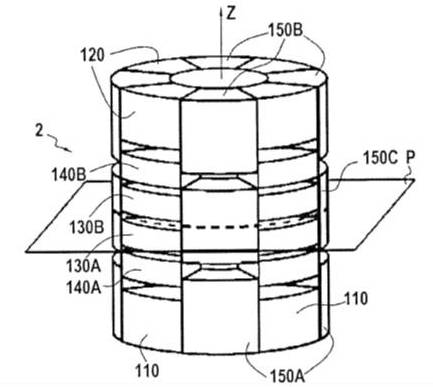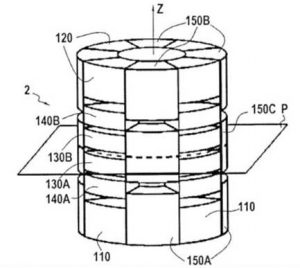Structure aimantée induisant en son centre un champ homogène d’orientation prédéterminée
Une structure aimantée induisant dans une zone d’intérêt centrale un champ magnétique homogène d’orientation prédéterminée par rapport à un axe longitudinal (z) de la structure, comprend deux couronnes aimantées (110, 120) disposées de façon symétrique par rapport à un plan (P), perpendiculaire à l’axe longitudinal (z) et contient la zone d’intérêt centrale. Une structure aimantée annulaire médiane est partiellement interposée entre les deux couronnes aimantées (110, 120) et disposée de façon symétrique par rapport au plan (P) de symétrie. L’une (110) des deux couronnes aimantées est aimantée radialement par rapport à l’axe longitudinal (z) avec une aimantation divergente, et l’autre (120) est aimantée radialement par rapport à l’axe longitudinal (z) avec une aimantation convergente. La structure aimantée annulaire médiane est aimantée avec une orientation différente de celle de l’aimantation des deux couronnes aimantées (110, 120). La structure aimantée annulaire médiane comprend au moins une couronne aimantée (150) présentant une distribution d’aimantation dont l’orientation varie comme dans les dipôles de Halbach et les deux premières couronnes aimantées (110, 120) ainsi que la structure aimantée annulaire médiane sont divisées chacune en éléments constitutifs individuels en forme de secteurs identiques régulièrement répartis.
Magnetised structure inducing a homogeneous field, in the centre thereof, with a pre-determined orientation (WIPO link)
The invention relates to a magnetised structure inducing a homogeneous magnetic field in a central zone of interest, the orientation of said field being pre-determined in relation to a longitudinal axis (z) of the structure. Said structure comprises at least two magnetised crowns (110, 120) symmetrically arranged in relation to a plane (P) that is perpendicular to the longitudinal axis (Z) and contains the central zone of interest, and at least one median annular magnetised structure at least partially inserted between the two magnetised crowns (110, 120) and also arranged symmetrically in relation to the plane (P) of symmetry, one (110) of the two magnetised crowns being radially magnetised in relation to the longitudinal axis (z) with a divergent magnetisation, and the other (120) of the two magnetised crowns being radially magnetised in relation to the longitudinal axis (z) with a convergent magnetisation. The median annular magnetised structure is magnetised with an orientation different from that of the magnetisation of the two magnetised crowns (110, 120). The median annular magnetised structure comprises at least one magnetised crown (150) having a magnetisation distribution with an orientation that varies as in the Halbach dipoles, and the two first magnetised crowns (110, 120) and the median annular magnetised structure are each divided into individual constitutive elements in the form of regularly distributed identical sections.
Contact: D. Sakellariou.



